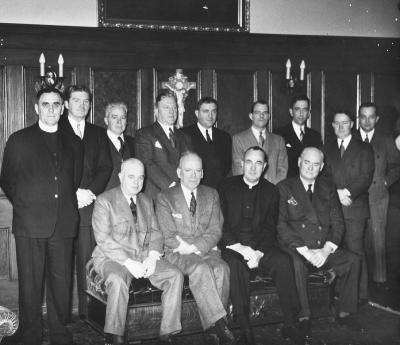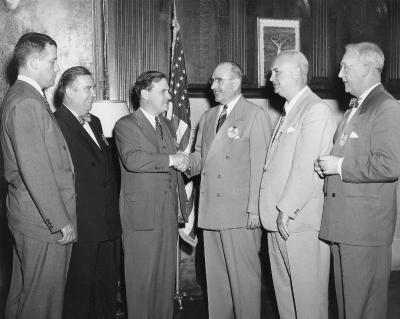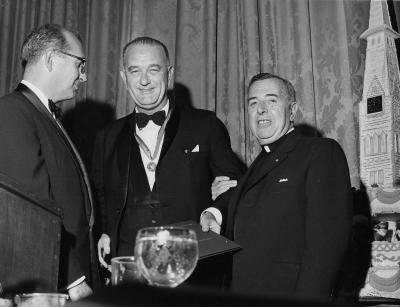The Georgetown University Alumni Association traces its history to an 1867 meeting on the day before commencement, at which a literary dinner was held. Although it was only sporadically organized prior to 1938, alumni groups assisted in several small-scale projects before that date, including decorating Gaston Hall in 1875 (resulting in it becoming known as "Alumni Hall" for some years afterward), the donation of the statue of University founder John Carroll in 1912, and a financial campaign in 1922 that funded the construction of New North and restoration of Old North.1
Founding
The first meeting of the Association took place on May 14, 1880 at the home of Senator Francis Kernan. The Association's constitution was adopted at the second meeting, which took place on May 26 of that year at the home of William Wilson Corcoran.2 Corcoran was elected president, Kernan first vice president, Richard Thomas Merrick second vice president, John F. Hanna secretary, and Patrick F. Healy, S.J., treasurer.3
Return of the Alumni Association
In 1938, University president Arthur A. O'Leary, S.J., asked Professor James S. Ruby to head a formally organized Alumni Association. The Association's first office was an anteroom of the University president's office containing a desk and a file of alumni names and addresses. The Association's first publication was a four-page Alumni Bulletin published in August 1938. This publication is credited with attracting the largest meeting of Georgetown Alumni to that point, when over 1,000 graduates attended the University's sesquicentennial celebration in May 1939.
In June 1940, representatives of 33 regional and local Alumni Clubs met at the University to discuss establishing a permanent association. The meeting was led by Frank J. Hogan (1902), who had been the last elected officer of the older alumni organization in 1919. The group elected Martin F. Conboy (L 1898) as its first president. He served in that capacity from 1940-1944. The organization also drafted a constitution and established a fee of $3.00 per year for dues-paying members. 236 members joined in the Association's first year, and it moved to a larger office on the ground floor of White-Gravenor.
In August 1947, Association President Thomas A. Dean (C 1920) incorporated the Association, making it autonomous from the University.4 In 1951 it moved from a two-room suite in Healy Hall to Alumni House.5 In October 2005, the Alumni House was named for Robert (F'48) and Bernice Wagner for their gifts in renovating the House.
Alumni Association's Events
The Alumni Association confers multiple esteemed awards to Georgetown alumni. The Timothy S. Healy, S.J. Award is given to an alumnus who has demonstrated an exemplary record in community service, public service, or professional service of a humanitarian cause. The Patrick Healy, S.J. Award was established in 1969 and is given to an individual who is not a Georgetown alumnus but whose record of service exemplify Georgetown's values. Lastly, the John Carroll Award is the highest honor bestowed by the Alumni Association for alumni whose achievements best demonstrate the ideals and traditions of Georgetown. In 1963, the John Carroll Awards Dinner was held in the Waldorf-Astoria Hotel in New York and the award was given to Vice President Lyndon B. Johnson.
In 1985, the Board of Governors approves the construction of an alumni residence in honor of former Executive Secretary James P. Reed, to serve for University-related functions and the residence of the executive director of the Alumni Association.
- 1John J. Tunmore, "The Alumni Association...Its History," Georgetown University Alumni Association Magazine, March 1954, Vol. 6, No. 6, pp. 5, 12. http://hdl.handle.net/10822/709108
- 2"The Alumni Association," Georgetown College Journal, June 1880, Vol. 8 No. 8, p. 88. http://hdl.handle.net/10822/1044331
- 3"The Alumni Meeting," Georgetown College Journal, July 1881, Vol. IX No. 10, p. 110. http://hdl.handle.net/10822/1044342
- 4John J. Tunmore, "The Alumni Association...Its History," Georgetown University Alumni Association Magazine, March 1954, Vol. 6, No. 6, pp. 5, 12. http://hdl.handle.net/10822/709108
- 5Raymond T. Cahill, "The Story of Alumni House," Georgetown University Alumni Association Magazine, March 1954, Vol. 6 No. 6, p.9. http://hdl.handle.net/10822/709108




